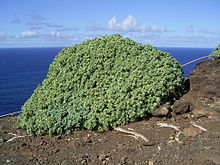Balsam milkweed
| Balsam milkweed | ||||||||||||
|---|---|---|---|---|---|---|---|---|---|---|---|---|

Balsam milkweed, La Palma |
||||||||||||
| Systematics | ||||||||||||
|
||||||||||||
| Scientific name | ||||||||||||
| Euphorbia balsamifera | ||||||||||||
| Aiton |
The balsam spurge ( Euphorbia balsamifera ) (span. "Tabaiba dulce") is a plant type from the genus spurge ( Euphorbia ) in the family of Euphorbiaceae (Euphorbiaceae). It is a characteristic element of the Canary Islands coastal zone. It is the natural symbol of Lanzarote .

features
The balsam milkweed is a heavily branched, semi-succulent shrub that can reach a height of 5 m. A short trunk can also be formed, the growth habit is often hemispherical or almost spherical. At locations exposed to the wind, the bushes are often more or less pressed to the ground. The branches are strong and gray in color, covered with transverse leaf scars. The leaves are linear-lanceolate and measure 8 × 0.8 cm. The leaves are clumped together on the shoots. The leaves are gray-green, the uppermost, smaller leaves are light green. The leaves are thrown off during dry periods. At the end of the shoot sits a single cyathium (also with a short stalk) with five brown-red or yellowish, broadly elliptical nectar glands. The cyathium measures 6 mm in diameter. The seed capsule is 1 cm in diameter, reddish and hairy. The seeds have a smooth surface and are almost spherical (3 × 2.8 mm).
The number of chromosomes is 2n = 20 for both subspecies.
ingredients
The white milky juice is considered non-toxic.
Systematics and distribution
One can distinguish between two subspecies:
- The subspecies Euphorbia balsamifera subsp. balsamifera (Syn .: Euphorbia balsamifera subsp. rogeri (NEBr.) Guinea , Euphorbia balsamifera subsp. sepium (NEBr.) Maire ): occurs in the Canary Islands and from West Africa (Senegal, Mauritania, Burkina Faso, Mali, Niger) to Chad before. In the Canary Islands, it is one of the character species of the coastal zone. They often form large populations in this zone.
- The occurrence of the subspecies Euphorbia balsamifera subsp. adenensis (Deflers) PROBally (Syn .: Euphorbia adenensis Deflers ) extends from Sudan to the south of the Arabian Peninsula and the island of Abd al-Kuri . It occurs there in rocky, calcareous or gypsum-containing soils that are covered with low shrubbery. It grows there to an altitude of 900 to 1550 m. With a height of about 1 m, the bushes are significantly smaller than in the other subspecies. The leaves are also somewhat smaller and have a slightly different shape (obovate).
See also
literature
- David Bramwell and Zoe I. Bramwell: Flores Silvestres de las Islas Canarias. 376 pp., Edicion Rueda, Madrid. 1994 ISBN 84-7207-062-X
- Peter Schönfelder and Ingrid Schönfelder: The cosmos of the Canary Islands flora. 2nd edition, 319 pages, Franckh-Kosmos Verlags-GmbH & Co KG Stuttgart ISBN 978-3-440-10750-8
- Urs Eggli (ed.): Succulent lexicon. Volume 2 Dicotyledonous plants (dicotyledons) excluding Aizoaceae, Asclepiadaceae, Cactaceae and Crassulaceae. 579 pp., Eugen Ulmer Verlag, Stuttgart. ISBN 3-8001-3915-4
Individual evidence
- ↑ Ley 7/1991, de 30 de April, de símbolos de la naturaleza para las Islas Canarias
- ↑ Euphorbia balsamifera at Tropicos.org. In: IPCN Chromosome Reports . Missouri Botanical Garden, St. Louis
- ↑ a b c Rafaël Govaerts (Ed.): Euphorbia - World Checklist of Selected Plant Families of the Royal Botanic Gardens, Kew. Last accessed on May 20, 2017.
Web links
- Euphorbia balsamifera . In: U. Brunken, M. Schmidt, S. Dressler, T. Janssen, A. Thiombiano, G. Zizka: West African plants - A Photo Guide. Senckenberg Research Institute, Frankfurt am Main 2008.

